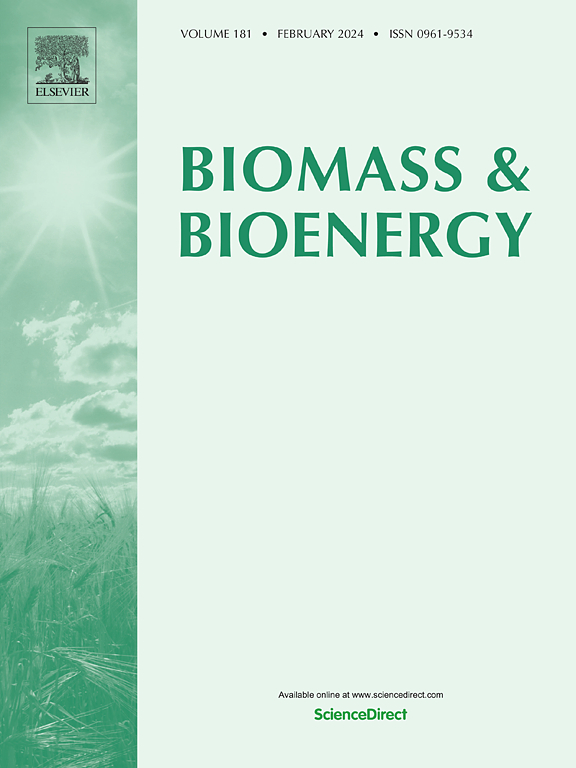The effect of combining mineral salt with ball milling for promoting enzymatic saccharification of cellulose
IF 5.8
2区 生物学
Q1 AGRICULTURAL ENGINEERING
引用次数: 0
Abstract
Clean and efficient pretreatment is a critical process for producing cellulosic sugar platform for the production of advanced biofuels and chemicals. Combining a chemical treatment with ball milling is a relatively simple and environmentally friendly procedure, which may reduce the pretreatment time and energy consumption. Hence, in this study, the mineral salts (e.g. ZnCl2, ZnBr2, LiCl, and LiBr) were used to enhance the ball milling. Firstly, microcrystalline cellulose (MCC) as a model compound of pure cellulose was pretreated by mineral salt-assisted ball milling to investigate the effect of mineral salt and ball milling for promoting cellulose saccharification. LiBr showed the best effect to improve the effectiveness of ball milling pretreatment, and the glucose yield of saccharification reached up to 93.8 % under the optimal conditions. Then, corncob residue (CCR) as a distinctive starting material was pretreated by LiBr-assisted ball milling, and the corresponding glucose yield of saccharification (48 h) with enzyme dosage of 5 FPU/g-CCR was as high as 97.4 %. Characterization verified that, the effect of LiBr and ball milling could more effectively break hydrogen bonds and crystalline structure of cellulose, thus highly promoting the followed enzymatic saccharification without lignin removal and washing after LiBr-assisted ball milling pretreatment. This work can help to understand the effect of combining mineral salt with ball milling, which is beneficial to the development of clean and effective pretreatment approach for lignocellulose biorefinery.
无机盐与球磨配合促进纤维素酶解糖化的效果
清洁高效的预处理是生产纤维素糖的关键工艺,是生产先进生物燃料和化工产品的平台。化学处理与球磨相结合是一种相对简单和环保的方法,可以减少预处理时间和能耗。因此,在本研究中,使用矿物盐(如ZnCl2, ZnBr2, LiCl和LiBr)来增强球磨。首先,以微晶纤维素(MCC)作为纯纤维素的模型化合物,采用无机盐辅助球磨法对其进行预处理,考察无机盐和球磨对纤维素糖化的促进作用。LiBr对球磨预处理效果的提高效果最好,在最佳条件下糖化葡萄糖得率可达93.8%。以玉米芯渣(CCR)为原料,采用lib辅助球磨法进行预处理,酶投加量为5 FPU/g-CCR时,48 h糖化葡萄糖产率高达97.4%。表征证实,LiBr和球磨的作用可以更有效地破坏纤维素的氢键和晶体结构,从而极大地促进了LiBr辅助球磨预处理后的后续酶解糖化,而无需去除木质素和洗涤。本研究有助于了解无机盐与球磨结合的效果,有利于开发清洁有效的木质纤维素生物精制预处理方法。
本文章由计算机程序翻译,如有差异,请以英文原文为准。
求助全文
约1分钟内获得全文
求助全文
来源期刊

Biomass & Bioenergy
工程技术-能源与燃料
CiteScore
11.50
自引率
3.30%
发文量
258
审稿时长
60 days
期刊介绍:
Biomass & Bioenergy is an international journal publishing original research papers and short communications, review articles and case studies on biological resources, chemical and biological processes, and biomass products for new renewable sources of energy and materials.
The scope of the journal extends to the environmental, management and economic aspects of biomass and bioenergy.
Key areas covered by the journal:
• Biomass: sources, energy crop production processes, genetic improvements, composition. Please note that research on these biomass subjects must be linked directly to bioenergy generation.
• Biological Residues: residues/rests from agricultural production, forestry and plantations (palm, sugar etc), processing industries, and municipal sources (MSW). Papers on the use of biomass residues through innovative processes/technological novelty and/or consideration of feedstock/system sustainability (or unsustainability) are welcomed. However waste treatment processes and pollution control or mitigation which are only tangentially related to bioenergy are not in the scope of the journal, as they are more suited to publications in the environmental arena. Papers that describe conventional waste streams (ie well described in existing literature) that do not empirically address ''new'' added value from the process are not suitable for submission to the journal.
• Bioenergy Processes: fermentations, thermochemical conversions, liquid and gaseous fuels, and petrochemical substitutes
• Bioenergy Utilization: direct combustion, gasification, electricity production, chemical processes, and by-product remediation
• Biomass and the Environment: carbon cycle, the net energy efficiency of bioenergy systems, assessment of sustainability, and biodiversity issues.
文献相关原料
公司名称
产品信息
阿拉丁
Na3C6H5O7·2H2O
阿拉丁
C6H8O7
阿拉丁
H2SO4
阿拉丁
LiBr
阿拉丁
LiCl
阿拉丁
ZnBr2
阿拉丁
ZnCl2
阿拉丁
Na3C6H5O7·2H2O
阿拉丁
C6H8O7
阿拉丁
H2SO4
阿拉丁
LiBr
阿拉丁
LiCl
阿拉丁
ZnBr2
阿拉丁
ZnCl2
阿拉丁
Microcrystalline cellulose (MCC)
阿拉丁
Microcrystalline cellulose (MCC)
 求助内容:
求助内容: 应助结果提醒方式:
应助结果提醒方式:


